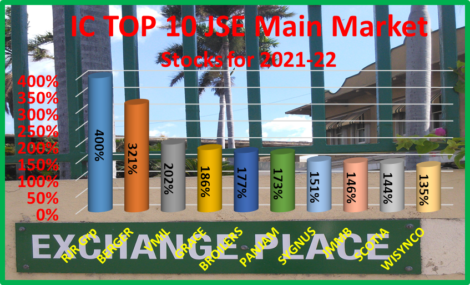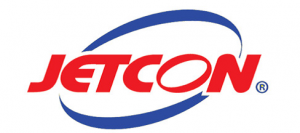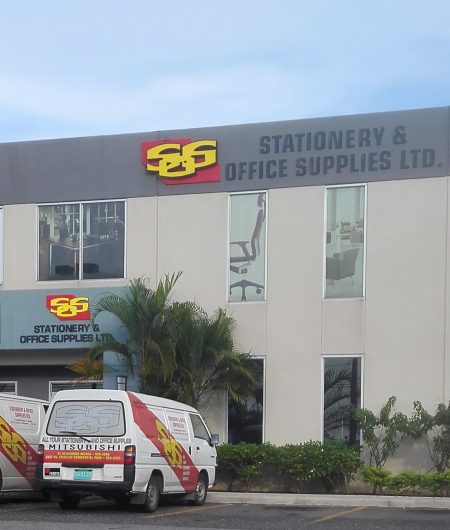Junior Market stocks were affected by the dislocation caused by the COVID-19 virus more than their Main Market counter path, with their prices suffering more as well, but since March last year, the Junior market delivered greater returns than the majors. For 2021 to date, Junior Market stocks are up almost 10 percent while the main market is down modestly.

ICTOP10 Junior Market stocks now.
The future for some stocks in 2021 is clear, but for others, it is a bit hazy as they await the resumption of normal business operations. This publication sets out the rationale for the TOP15 selection in the Junior Market.
Since we published the TOP 15 lists at the beginning of the year, the Junior Market is up almost 10 percent with outstanding performances from some of the selections, with most moving out of the TOP 15 lists except Grace Kennedy and Caribbean Cream. Jamaican Teas is up 69 percent, Mailpac 31 percent, Caribbean Cream 11 percent, Lumber Depot up 60 percent, QWI Investments up 38 percent, and Grace Kennedy up 19 percent.
Assumptions were made pertaining to recovery and the extent for some stocks in the TOP15 list. Some investors may start to react to recovery potential for some and drive prices up before full recovery takes place. Stocks falling into this category are Caribbean Producers, Elite Diagnostics, Express Catering, Jetcon Corporation, Main Event, Stationery and Office Supplies.
The forecast is for price movements to get to their targets by March 2022. Earnings per share for some stocks are based on 2021/22 EPS for companies with year ending up to July 2021.
Lasco Financial –EPS 50 cents Current PE 5.4
Lasco Financial made large provisions for loan losses in the 2020 fiscal year amounting to $651 million and plunged it into a $57 million loss for the year. They provided an additional $193 million in the June quarter that pushed the quarterly results into a $106 million loss.
Provision for loan losses was down to $152 million at the half-year and fell further to just $9 million for the nine months to December, thus reversing the provisions up to September.
The company recorded profit after tax for the September 2020 quarter of $136 million, with Profit after tax for the six months to September amounting to $30 million.
The December 2020 revenues were down from September by $88 million to $527 million and below the 2019 quarter by $73 million. The main reason for the fall in revenues in December versus 2019 is due to a $70 million fall in interest income from loans. Loan interest income grew from$143 million in the September quarter to $158 million in the December quarter. Profit to December is up to $154 million from $77 million in 2019. Full-year results could come in at $300 million
In their September quarterly, the company indicated that “there will now be a shift towards lending again, however, as opportunities for lending are now beginning to manifest as businesses are adjusting to the new normal, with some embracing new opportunities.” The shift to increase lending will add to revenues and profit going forward, with IC Insider.com projecting 20 cents per share to March and 50 cents for the fiscal year 2022. The company traded at $2.76 at the end of December and last traded at $2.70.
Shareholders equity stood at $1.69 billion and borrowed debt of $1.7 billion at the end of December 2020.
 Caribbean Cream – EPS 95 cents Current PE 5.
Caribbean Cream – EPS 95 cents Current PE 5.
“A breath of fresh air” is how the recently opened Ocho Rios Caribbean Cream depot was described by a customer, according to the principals of the company in a report to shareholders accompanying the third-quarter results. This new location is expected to contribute positively to the growth of the product and results going forward.
For the November quarter, profit after tax grew 36 percent to $11 million and 96 percent to $85 million for the year to date. Revenue improved by 11 percent for the quarter to $441 million and eight percent for the nine-month period. Administrative and marketing expenses grew by 15 percent for the quarter and four percent for the year, totaling $127 million and $343 million, respectively.
Earnings per share doubled from 11 cents to 22 cents for the nine months and moved from two cents to three cents for the November quarter. The final quarter is the best for revenue generation and profit. Accordingly, ICInsider.com forecast is for full-year earnings of 50 cents for the year to February 2021 and 95 cents for the following year. Shareholders’ equity grew by 12 percent over November 2019 to $818 million and the company has loans payable of $226 million. The company traded at $4.20 at the end of December and at $4.65 on Friday.
Caribbean Producers – EPS 65 cents Current PE 4.
This company’s profit was badly affected by dislocation in the tourism sector and full recovery will depend on the industry recovering substantially as a large portion of its revenues is dependent on the fortunes of the sector. CPJ started their new fiscal year with an improvement over the final quarter ended in June 2020 but notably off the mark compared with the corresponding quarter for 2019.
Revenues dropped by 65 percent from September 2019 to US$9.3 million, with gross profit falling 64 percent to US$2.4 million from 2019 out turn. The improvement over the June quarter coincides with the reopening of hotels and it should pick up further with Jamaica’s tourist arrivals hitting the 90,000 mark in December, from an average of less than 50,000 in the September quarter. Revenues in the December quarter climbed further to $15 million
Selling and administrative expenses declined slower than gross profit, falling by 51 percent, while depreciation charges jumped from $767 million to $1.07 million. CPJ moved from a loss of US$258 thousand in 2019 to a loss of US$1.85 million in the September quarter and $850,000 in the second quarter.
Shareholder’s equity stood at US$15.3 million with loans payable of $30.4 million and is highly over-leveraged at the end of 2020. The overleveraging at this time is a big negative just in case things take a longer time to return to some level of normality. Regardless, this is an area of operations that needs urgent attention.
The stock is likely to be a late bloomer, with earnings per share projected at 65 cents for the 2022 fiscal year ending June, assuming near full recovery in the hotel sector. The stock traded $2.80 at the end of December and traded at $2.67 on Friday. The potential for recovery exists, but the heavy debt loan makes it a riskier investment.

Main Event revenues recovering.
Main Event – EPS 67 cents Current PE 4.6
The arrival of COVID-19 virtually crippled the entertainment industry as nighttime curfews and social distancing halted many entertainment activities, a big earnings area for the company.
For the quarter ending July 2020, revenues were slashed 87 percent to $59 million and for the nine months to July 2020, dropped 31 percent from $1.37 billion to $945 million. Expenses were down by 98 percent for the quarter to $19 million and 31 percent for the year to $521 million.
MEEG recorded a net loss of $46 million for the July quarter and a net profit of $8.7 million for the year to date.
The depreciation charge accounted for $31 million of the quarter’s loss and $95 million for the nine months, resulting in positive profit before the depreciation charge and a small quarterly cash loss in the July quarter.
For the full year, the company reported a loss of $18 million with a depreciation of $148 million for a strong positive profit before depreciation. In the final quarter, revenues climbed over July quarter by 69 percent to $101 million and recorded a much lower loss of $27 million than in the third quarter with a depreciation charge of $53 million. It is unclear when the operation will return to good health. The early signs of improved revenues and positive cash flows augur well and placed them in a good position to weather the current economic storm with positive cash flow.
Cash funds amount to $132 million and loans of $238 million. Shareholders equity stood at $534 million at October 2020.
The company traded at $3.20 at the end of December and traded at $3.04 on Friday.
Elite Diagnostic – EPS 60 cents Current PE 4.6
The company came to market in 2018, with the previous year’s pretax profit at $60 million from just one location. Since then they have tripled locations with revenues rising 67 percent from $263 million in 2018 fiscal year to $439 million last year, but profit fell sharply with startup cost out weighting revenue increase.

ICInsider.com TOP10 Main market stocks.
A number of negative developments were at play driving up cost without the necessary increase in revenues. Expansion by its very nature incurs cost ahead of revenue generation. The company encountered problems with equipment, resulting in unscheduled repairs and cost and loss of revenues and finally, the advent of Covid-19 reduced opening hours and revenues.
The first quarter numbers to September last year were heavily impacted by reduced operating hours resulting in curtailed operations. The Directors note that a CT machine was not functional for an extended period, adversely affecting procedures they were able to undertake. The compounded fallout was net loss of $10.3 million for the September quarter down 162 percent from a net profit $16.7 million recorded for the September 2019 quarter and is a slight improvement over the June quarter’s loss of $12.5 million.
For the year to June 2020, net profit came in at just $8.6 million, an 83 percent drop from the previous year’s profit of $51 million as well as a decline from a profit of $23 million up to December 2019 with the March 2020 quarter showing strong promise with revenues of $236 million and profit of $21 million.
Revenue slipped by 7 percent for the September quarter to $110 million compared to 2019 but importantly, was up 20 percent over the June 2020 quarter. Operating expenses increased by six percent year-over-year to $42 million. The Directors state that the company has seen month-over-month revenue growth at the recently opened St. Ann location and expect to positively impact revenues for 2021.
The history of the company suggests, investors need to be patient for things to return to normal and for the St Ann branch to start generating adequate revenues and then profit.
Shareholder’s equity stood at $449 million at the end of September 2020, down from $460 million at the end of June 2020 and borrowed funds stood at $219 million. At the close of 2020, Elite Diagnostic traded at $3 at the end of December and traded at $2.76 on Friday. Earnings of 60 cents per share projected for the 2021/22 fiscal year.
 Jetcon Corporation – EPS 15 cents Current PE 5
Jetcon Corporation – EPS 15 cents Current PE 5
Reeling from the impact of COVID-19, profit at Jetcon dropped significantly year-over-year, for the quarter and the nine month period ending September 2020, which is expected to lead to vastly reduced 2020 full year results compared to 2019. A profit of $2 million was reported for the September quarter, down 91 percent from 2019 and $5.6 million for the year to date, a decline of 88 percent. The result was an improvement over the June’s quarter loss of $6.7 million. Sales fell 45 percent for the quarter to $153 million and by 38 percent to $467 million for the year but reflected a 78 percent improvement on the June quarter’s figures of $86 million.
Administrative and other expenses was flat at $23 million for the September quarter versus the similar period in 2019 and fell to and $71 million year to date versus $80 million in 2019.
The industry goes through years of boom and bust and could be returning to a period ahead of growth in revenues. The industry has gone through three years of declining sales, an unusual development that bodes well going into 2021 as it could mean that the downward cycle is at an end. Importantly, due to the poor sales in the second quarter last year, resulting in a loss, the company should enjoy better June quarter results all things being equal if the country continues on its current path of recovery.
Net current assets stood at $444 million at September 2020. Shareholders equity stands at $552 million and it has very limited debt that provides a good base for continued operations going forward.
The company traded at 79 cents at the end of December and traded at 77 cents on Friday with earnings per share that could rise in the region of 15 cents for 2021 assuming some major about-turn in demand for cars.
Medical Disposables – EPS 80 cents Current PE 5.6
Medical Disposables enjoyed a 12 percent increase in revenue during the quarter ending September 2020 to $630 million. For the six months, revenues hit $1.14 billion, only a two percent increase but Direct Expenses jumped 11 percent for the quarter to $480 million and $877 million for the six months. There was an after tax loss of $6 million compared to an after-tax profit of $6 million for the quarter ending September 2019. The six month figures stood at a loss of $13 million and a profit of $23 million respectively. The General Manager notes the impact of the one-off finance cost pushed the charge for the quarter to $36 million, without which the company would have generated a profit around $20 million. The company reported profit of $25 million or ten cents per share in the December quarter, up from $6.5 million in 2019, with sales rising moderately from $603 million to $626 million.
While ICInsider.com is projecting ongoing earnings of 30 cents per share for the fiscal year to March. The performance is expected to improve, with earnings of 80 cents per share for the 2022 fiscal year.
The company had net current assets of $374 million, inclusive of cash and bank balances of $23 million at the end of September, a 271 percent increase over the company’s cash position at the end of September 2019. Total equity stood at $846 million with borrowings of $735 million.
Medical Disposables ended the calendar year at $4.25 at the end of December and traded at $4.20 on Friday with earnings of 60 cents per share. Investment in the stock is not without some risk in the short term, but there could be upside surprises if the company attracts new business lines as they have been doing in recent years.
Caribbean Assurance Brokers – EPS 35 cents Current PE 5
According to the Chairman’s report decline in commission in all four divisions as well as a delayed renewal period for the international health insurance product, contributed to sluggish revenue for the period to September 2020. Total revenue for the quarter dropped 61 percent to $79 million and down by 37 percent for the nine months to $23 million. The company recorded a loss of $10 million, a drop from a profit of $62 million for the corresponding quarter in 2019. For the six-month period, losses stood at $23 million, down from a profit of $57 million recorded at the end of September 2019. Shareholders equity stood at $278 million at the end of September 2020, up from $230 million at the end of December 2019. CAB has net current assets of $107 million, a 12 percent increase over the corresponding period. At the close of 2020, the stock traded at $1.89 and at $1.76 on Friday, with earnings per share of 25 cents for 2020.
Access Financial – EPS 2.70 cents Current PE 7.6
Access Financial is the classic case where looking ahead rather than focusing heavily on the recent past can pay off richly. The advent of Covid-19 in Jamaica meant dislocations for many businesses and loss of jobs. Access had to face this onslaught head-on resulting in a massive increase in provisioning for expected credit losses. Most of that seems to be behind them now, with the September quarter showing recoveries of some doubtful loans and lower provisions made for additional expected losses. The company still provided $111 million in the quarter for doubtful debt and $178 million for the six months, compared with $105 million and $185 million in 2019 respectively and made further provision of $111 million in the December 2020 quarter, putting total provisions around $800 million and covering more than half of loans overdue for up to 30 days. This is an indication that provisions in the near future could be much more moderate than in the past two years.
Profit suffered in the current fiscal year as net profit fell 75 percent to $28.5 million for the September quarter and 77 percent to $62 million for the six-month period. For the December quarter, Profit before taxation rose to $94 million from $33 million in the September quarter, compared to $121 million in December 2019 after another round of heavy loan loss provision.
Net operating income fell 20 percent for the six months at $887 million and 20 percent from September 2019 at $457 million, but the latter was an improvement on the June 2020 quarter of $430 million, by six percent. For the December quarter, it grew to $460 million. Meanwhile, at $370 million, total interest income fell 12 percent from the September 2019 quarter versus 2019, but was down only two percent from the June quarter and increased further to $387million in the December quarter.
At the end of September, Loan receivables were down 13 percent to $3.9 billion from $4.47 billion at March 2020 and $4.4 billion at the end of September 2019 as the company increased bad debt provision curtailed lending up to that point. Loans advanced rose to just over $4 billion, which is an encouraging sign in pursue of an increase in revenues and profit going forward.
Shareholders’ equity stood at $2.3 billion. The company had loans payable of $2.65 billion, down from $3.1 billion in December 2019 and $3.2 billion at the end of March 2020. Cash and cash equivalents ended at $555 and total assets at $5.5 billion.
The stock ended trading in 2020 at $23.50 and traded at $21 on Friday. With earnings of $1 per share projected for the current fiscal year that would result in a PE ratio of 21 and a 2022 forecast of $2.70 per share, suggesting good potential upside for the stock price.

Stationery & Office Supplies – Montego Bay office.
Stationery and Office Supplies – EPS 70 cents Current PE 6
Gross profit was down 19 percent for the quarter and 26 percent for the nine months ending September closely matching the fall in sales that fell 18.6 percent to $240 million from $295 for the quarter and down 24 percent to $712 million from $933 million for the nine months to September 2020. Net profit for the quarter fell 70 percent to $7 million and 75 percent for the nine months to $29 million.
The Board of Directors notes that its third-quarter corresponded with a surge in COVID-19 cases in Jamaica. Despite falling below 2019 numbers, the company managed to improve its performance over the June quarter. SOS also acquired property on the adjoining lot and finished its new warehouse, a sign of expected growth in operations going forward.
Shareholders’ equity increased by five percent to $625 million, but net current assets fell by nine percent to $343 million, with a strong cash position of $112 million, up from $87 million at the end of September 2019 and $62.5 million at the end of December 2019, the company is set to weather the continued COVID storms.
The company should be seeing improved results in 2021, with schools and some businesses reopening, especially since June last year. The company should be seeing marked improvement in numbers in the March to September periods compared to 2020, when many businesses closed or operated with reduced activities.
The company’s stock traded at $4.54 at the end of December and on Friday at $4.50 with expected earnings of 20 cents per share for 2020. The stock is about fully valued but undervalued based on improved 2021 earnings.

Jamaican Teas CEO John Mahfood
Jamaican Teas – EPS 30 cents Current PE 11
The company enjoyed increased profit with interim results for the December first quarter of the 2021 fiscal year show sales rising 41 percent to $611 million and profit attributable to shareholders jumping 321 percent to $117 million from just $28 million in 2019.
The highlight for the quarter was the strong gain in export sales of 88 percent over the prior year. This contributed to manufacturing sales climbing 48 percent to $428 Million for the quarter.
What is known subject to continuity, since the end of the 2020 fiscal year, QWI Investments net asset value has gained 15 cents or around $200 million and with more apartment sales to be completed in the second quarter, the group should see these contributing to profit subsequent to the December quarter.
The group has borrowings of $432 million and cash funds of $317 million at the end of December. Investments amount to $1.7 billion with shareholders’ equity of $1.8 billion.
After a three-to-one stock split in November last year, the company enjoys increasing buying interest, with the price hitting record highs in recent weeks. Jamaican Teas ended the calendar year with the stock at $1.99 and traded at $3.35 on Friday. It is the leading Junior Market stock for the year to date.
General Accident – EPS 90 cents Current PE 5.6
Last year, the group recorded results of the Trinidad subsidiary, for the full year, compared to a few months in 2019, and the Barbados startup, for a shorter period. Up to the second quarter, the company seems to be bettering the operating performance of 2019 but clams provisions relating to Trinidad subsidiary. The full-year results showed profit down to 32 cents per share at $323 million for shareholders of the company.
Net premiums earned increased by 3 percent from $801 million to $823 million for the December quarter and by 14 percent from $2.45 billion to $2.8 billion for the year. Gross premium income jumped 52 percent from $1.78 billion to $2.7 billion in the final quarter and 12 percent from $10.7 billion to $12 billion with insurance ceded rising sharply. Claim expenses rose in the quarter from $218 million to $428 million and for the year by 49 percent from $1.2 billion to $1.79 billion. Management expenses slipped by 4 percent for the quarter to $348 million from $361 million and rose 21 percent for the year from $992 million to $1.2 billion. Investment income dropped for the quarter from $116 million to $61 million and fell from $230 million to $202 million for the year. Other income also fell in both periods, with the year ending at $19 million from $202 million.
It is the performance in 2021 that is important and that should climb nicely with the expansions getting more matured, while the Jamaican operation continues to add to profit.
Shareholders’ equity was $2.6 billion at the end of December. The company traded at $6.19 at the end of December and traded at $5.30 on Friday with earnings of 32 cents per share.

Lumber Depot dominated trading with
Lumber Depot – EPS 22 cents Current PE 12.5
Lumber Depot operates a full-service hardware store and acquired the assets and liabilities of the Lumber Depot business from the Blue Power Group effective August 2019.
Net profit jumped 76 percent for the October quarter from $20.5 million to $36.1 million and ended at $66 million for the six months to October 2020, representing a 79 percent increase from the corresponding period in which the business operated in the prior half in its own right as under the Blue Power group for a quarter.
The company recorded revenue of $338 million for the quarter, a seven percent year-over-year improvement. Administrative expenses fell 15 percent to $39 million for the quarter ending at $77 million for the half-year.
“We have had downturns in some areas that have impacted us, such as the Gordon Town Road collapse but we are able to see improvements in sales in other areas that have helped to balance any shortfalls. Revenues and profits continue to be steady similar to the 2nd quarter which you will see when our next set of financials are published, “ the company’s Chief Accountant, Adrienne Jones, informed ICInsider.com in response to a request about the company’s operations currently.
Shareholders equity grew by 34 percent to $258 million from $192 million at the end of April 2020. The stock price was $1.56 at the end of December and traded at $2.50 on Friday. Earnings per share came in at 5 cents for the quarter and nine cents for the half-year is projected by ICInsider.com at 20 cents for the current fiscal year and 22 cents for the 2022 fiscal year.
Lasco Distributors – EPS 40 cents Current PE 8.5
Profit before taxation increased by 55 percent year-over-year for the December quarter moving from $188 million to $291 million. Pre-tax profit for the nine months climbed 41 percent from $618 million to $870 million. Taxation tripled for the quarter to $48 million and more than doubled for the nine-month period from $60 million to $139 million, leaving net profit rising 41 percent from $172 million to $243 million for the quarter and by 31 percent to $731 million for the nine months.
Revenue improved by six percent for the quarter to $5.2 billion and for the nine-month period to $15.2 billion. Operating expenses declined by 11 percent for the quarter and 12 percent for the nine months to $663 million and $2.02 billion, respectively, as management focused on cutting cost.
The company does all the sales for the manufacturing company; as such improved sales by them will positively impact revenues and profit.
Cash and investments climbed to $2.3 billion at the end of 2020, while shareholders equity stood at $6 billion at the end of December 2020 while borrowings were negligible. Lasco Distributors last traded at $3.68 on Friday with projected earnings of 30 cents per share to March and 40 cents for 2022.

Mailpac – EPS 30 cents Current PE 12
The Group continues to enjoy increasing strong profit growth despite the current pandemic, with revenue jumping 58 percent in the September quarter over the 2019 quarter, with profit more than doubling, helped by a is healthy profit margin at 62 percent. Revenues climbed from $301 million to $477 million and grew a stunning 30 percent over the June 2020 quarter with $366 million. For the year to September, revenues rose to $1.2 billion, 42 percent more than the $851 million recorded at the end of September 2019.
The company recorded a net profit of $149 million for the quarter, a solid 129 percent jump from the $65 million recorded for the September 2019 quarter. For the year-to-date, there was an even more sizeable growth of 150 percent, moving from $203 million in 2019 to $339 at the end of September 2020.
For the full year to December, Mailpac reported a 42 percent increase in revenues for the December quarter with a $512 million realised profit of $104 million, up from $97 million pretax for 2019. Cost of sales jumped 70 percent for the final quarter, much higher than the increase in revenues. Profit for the year ended at $443 million, with earnings per share of 18 cents with the increased direct cost in the final quarter robbing it of greater earnings. IC Insider.com believes that this type of business will continue to grow as persons are attracted to the convenience that the service affords.
At the end of December, cash and equivalent stood at $292 million, while Shareholders’ equity stood at $571 million with little or no borrowings. A dividend of 6 cents was declared, payable in March and brought the total for the year to 15 cents.
The stock ended 2020 trading at $2.87 at the end of December and traded at $3.75 on Friday but traded as high as $4.43 in February before pulling back to close at $3.75 on Friday. ICInsider.com projects earnings per share of 30 cents for 2021.






